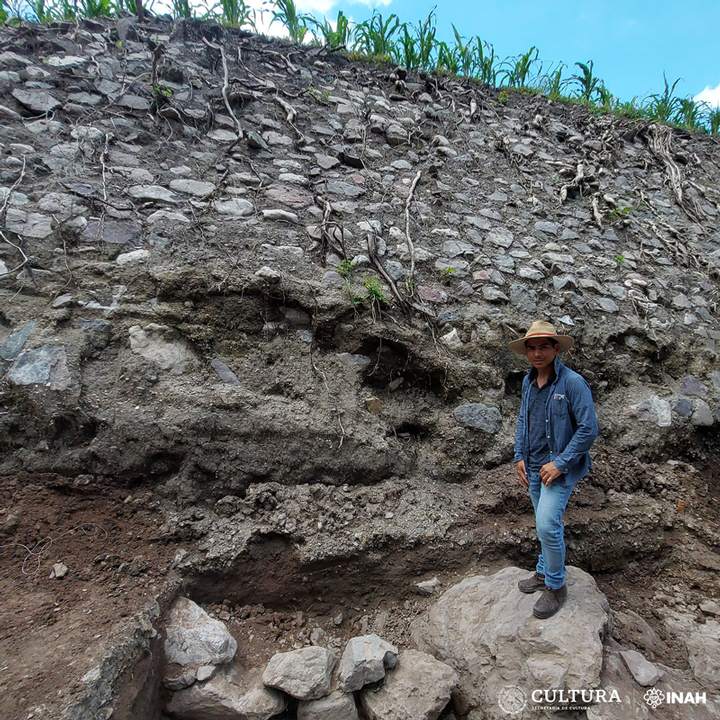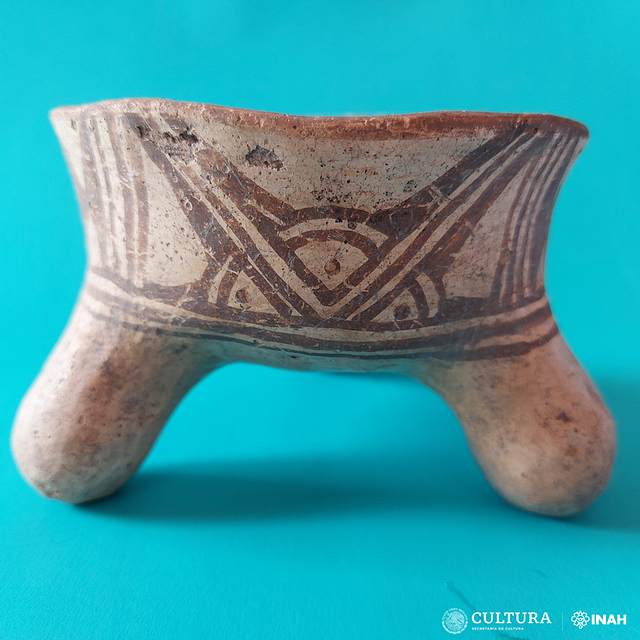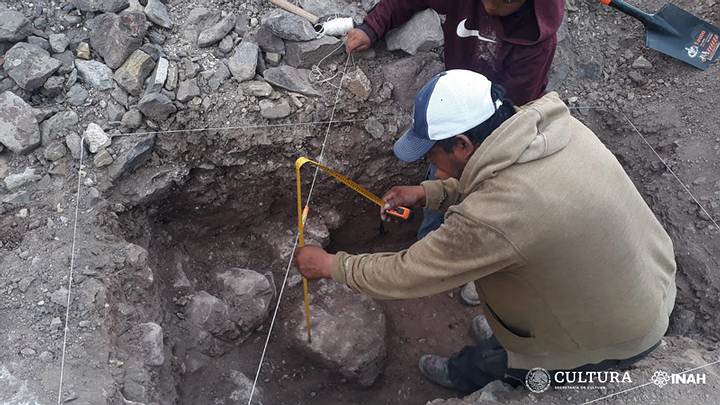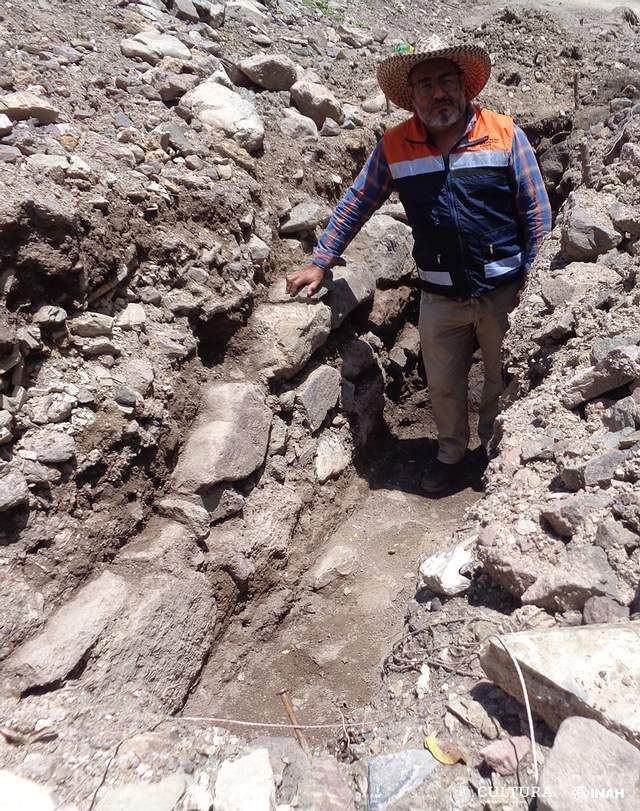Based on historical records, during the era preceding the Spanish colonization, the region was home to the Tepuztecs, an indigenous community that has since faded into history. Although the specifics of their language remain elusive, they were bestowed the name “Tepuzque” by the Mexicas, a reference to their accomplished metallurgical craftsmanship.

Credit: Miguel Perez Negrete/INAH.
The recent expansion of the Puerto del Varal-Corral de Piedra highway within the state of Guerrero, Mexico, has unveiled a remarkable pre-Hispanic wall. Stretching an impressive 34 meters in length and towering seven meters in height, this wall constitutes the initial tier of a three-tiered architectural structure nestled within the municipality.
Referred to as Barranca Chihuila-Corral de Piedra, this site forms part of a cluster of pre-Hispanic settlements encompassing an estimated 1.5 square kilometers. These historical regions intricately align with the modern township of Corral de Piedra.
In the course of the archaeological rescue mission overseen by the Ministry of Culture of the Government of Mexico, and executed by experts from the esteemed National Institute of Anthropology and History (INAH), fragments of both human and animal skeletal remains have surfaced. These remnants were utilized as components in the construction of the pre-Hispanic wall. Additionally, the interment of a young child was brought to light—a child believed to have been three to five years of age at the time of demise.

Credit: Moises Nava Nava.
The interment unveiled an assortment of grave offerings, including ornate green stone beads, resonant copper bells, delicately crafted shell earrings, a distinctive seal, and a Yestla-El Naranjo style tripod bowl. This artifact holds profound archaeological significance, encapsulating a later cultural epoch within the expanse that presently forms the state of Guerrero. Encompassing the span from the waning days of the Mezcala culture through to the advent of the Spanish colonial era, this period extends from the 1000s to the year 1521 AD.
It’s noteworthy to recollect that the area where this remarkable find was unearthed, in conjunction with the neighboring localities of Yextla, Huerta Vieja, and El Naranjo, underwent exploration by the archaeologist Robert R. Weitlaner from 1944 to 1946. During this investigative phase, the distinct ceramic style of Yestla-El Naranjo was identified. It’s also of significance that Weitlaner documented a prolific presence of copper slag, signifying the advanced metallurgical knowledge prevalent within these ancient communities.

Credit: Miguel Perez Negrete/INAH.
Per historical accounts, during the twilight of the pre-Hispanic era, the region bore witness to the presence of the Tepuztecs, a now-extinct ethnic community. While the specifics of their language have evaded documentation, the Mexicas bestowed upon them the name “tepuzque,” a term intricately linked to their adeptness in metallurgy, particularly in working with copper alloys. In the local context of the mountainous terrain, the Tepuztecs were recognized as Tlacotepehuas, and their center of authority was located in Tlacotepec.
Abundant Pre-Hispanic Settlement Tepuztecs
The research leads Miguel Pérez Negrete and Laura Lucero Hernández accentuate the sheer architectural significance of this recent revelation. This expanse boasts a rich history of pre-Hispanic habitation, an area that had remained largely unexplored for a span of 77 years. Joining in this endeavor were the physical anthropologist Jorge Cervantes Martínez, archaeologist Antonio Hermosillo Worley, and social anthropologist Moisés Nava Nava.
“Our insight into this ethnic group and their culture remains scant. However, it’s known that their religious reverence extended to deities such as Andut and Macuili Achiotl. The latter deity, embodying femininity, was symbolized through stone sculptures and paintings,” elucidated Pérez Negrete.

Credit: Laura Lucero Hernandez/INAH.
The significance of the stratigraphic wells and the meticulously traced sequence of occupation cannot be overstated in unraveling the cultural tapestry of the region. The archaeological dig has meticulously exposed the intricate wall construction techniques utilizing sizeable limestone blocks. These walls were adorned with a modest application of lime stucco, juxtaposed against resilient red stucco floors.
Furthermore, the unearthing has yielded fragments of gray obsidian and a profusion of ceramics dating back to the Postclassic era, with a particular emphasis on the Early Postclassic subperiod spanning from AD 950 to 1350.
Of particular interest is the dual monumental phases in the area’s occupation: an initial phase punctuated by signs of collapse and landslides, succeeded by the erection of a subsequent phase. This juxtaposition suggests a tale of abandonment followed by a subsequent reestablishment toward the latter end of the pre-Hispanic era—a dynamic that intriguingly aligns with the historical presence of the Tepuztecs.
“As we embark on this research, a treasure trove of fresh insights awaits regarding the enigmatic Tepuztecs, encompassing their intricate social fabric and cultural attributes. Equally captivating is the prospect of gaining a deeper comprehension of the epoch marked by the creators of the Yestla-Naranjo ceramics,” eloquently concluded Lucero Hernández.

Credit: Guillermina Valente Ramírez/INAH
The recognition of the pre-Hispanic wall owes its discovery to the vigilance of the Road and Airport Infrastructure Commission of the State of Guerrero. Their intervention, pausing ongoing construction efforts, paved the way for INAH experts to authenticate its historical significance.
Today, the erstwhile roadway has ceded its space to a contemporary thoroughfare, wherein the pre-Hispanic wall stands as a prominent visual fixture. It captivates the gaze and kindles curiosity among passersby, transforming the site into a compelling focal point within the vicinity.
Source: INAH
Shop amazing Anunnaki Merchandise at our store, Follow us on Facebook, Instagram, And For More Interesting Content Also Subscribe To Our Youtube Channel.





